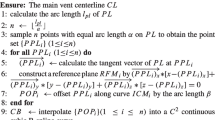Abstract
Venting system is an indispensable component of injection mold especially for the increasing demands of plastic articles with high quality. We propose a novel approach for automatic venting system generation on complex surfaces. The approach comprises three components, namely main vent centerline generation, main vent feature generation, and sub vent feature generation. The main vent centerline is generated by offsetting parting curve with equal arc length on complex surface. Multiple group key points are generated based on the main vent centerline, and the main vent features are generated by interpolating these points. The sub vent centerline is obtained by constructing the reference surface set and performing regular Boolean intersection with the parting surface. The sub vent feature generation process is the same as that of the main vent feature. A prototype system is also developed to improve the quality and efficiency of venting system design. Finally, a case study is provided to validate the proposed approach.










Similar content being viewed by others
Data availability
All data and models generated or used during the study appear in the submitted manuscript.
References
Kong L, Fuh JYH, Lee KS, Liu XL, Ling LS, Zhang YF, Nee AYC (2003) A Windows-native 3D plastic injection mold design system. J Mater Process Technol 139(1-3):81–89. https://doi.org/10.1016/S0924-0136(03)00186-9
Yin Z, Ding H, Xiong Y (2001) Virtual prototyping of mold design: geometric mouldability analysis for near-net-shape manufactured parts by feature recognition and geometric reasoning. Comput Aided Des 33(2):137–154. https://doi.org/10.1016/S0010-4485(00)00084-1
Fu MW, Fuh JYH, Nee AYC (1999) Undercut feature recognition in an injection mould design system. Comput Aided Des 31(12):777–790. https://doi.org/10.1016/S0010-4485(99)00070-6
Shayfull Z, Sharif S, Zain AM, Ghazali MF, Saad RM (2014) Potential of conformal cooling channels in rapid heat cycle molding: a review. Adv Polym Technol 33(1). https://doi.org/10.1002/adv.21381
Mok H-S, Kim C-H, Kim C-B (2011) Automation of mold designs with the reuse of standard parts. Expert Syst Appl 38(10):12537–12547. https://doi.org/10.1016/j.eswa.2011.04.040
Mercado-Colmenero JM, Paramio MAR, Perez-Garcia JM, Martin-Donate C (2016) A new hybrid method for demoldability analysis of discrete geometries. Comput Aided Des 80:43–60. https://doi.org/10.1016/j.cad.2016.06.006
Fu MW, Nee AYC, Fuh JYH (2002) The application of surface visibility and moldability to parting line generation. Comput Aided Des 34(6):469–480. https://doi.org/10.1016/S0010-4485(01)00117-8
Li CL (2003) Automatic parting surface determination for plastic injection mould. Int J Prod Res 41(15):3529–3547. https://doi.org/10.1080/0020754031000098939
Hou B, Huang Z, Zhou H, Li D (2018) A hybrid approach for automatic parting curve generation in injection mold design. J Adv Manuf Technol 95(9-12):3985–4001. https://doi.org/10.1007/s00170-017-1497-1
Lin AC, Quang NH (2015) A multiple slicing approach to automatic generation of parting curves. Proc Inst Mech Eng B J Eng 230(12):2165–2181. https://doi.org/10.1177/0954405415585271
Ye XG, Fuh JYH, Lee KS (2001) A hybrid method for recognition of undercut features from moulded parts. Comput Aided Des 33(14):1023–1034. https://doi.org/10.1016/S0010-4485(00)00138-X
Yen C, Lin JC, Li W, Huang MF (2006) An abductive neural network approach to the design of runner dimensions for the minimization of warpage in injection mouldings. J Mater Process Technol 174(1):22–28. https://doi.org/10.1016/j.jmatprotec.2005.02.233
Sun Z, Hu H, Chen X (2008) Numerical optimization of gating system parameters for a magnesium alloy casting with multiple performance characteristics. J Mater Process Technol 199(1):256–264. https://doi.org/10.1016/j.jmatprotec.2007.08.036
Zhai M, Lam YC, Au CK (2009) Runner sizing in multiple cavity injection mould by non-dominated sorting genetic algorithm. Eng Comput 25(3):237–245. https://doi.org/10.1007/s00366-008-0120-3
Li CL (2001) A feature-based approach to injection mould cooling system design. Comput Aided Des 33(14):1073–1090. https://doi.org/10.1016/S0010-4485(00)00144-5
Li CL, Li CG, Mok ACK (2005) Automatic layout design of plastic injection mould cooling system. Comput Aided Des 37(7):645–662. https://doi.org/10.1016/j.cad.2004.08.003
Li CG, Li CL (2008) Plastic injection mould cooling system design by the configuration space method. Comput Aided Des 40(3):334–349. https://doi.org/10.1016/j.cad.2007.11.010
Li CG, Li CL, Liu Y, Huang Y (2012) A new C-space method to automate the layout design of injection mould cooling system. Comput Aided Des 44(9):811–823. https://doi.org/10.1016/j.cad.2012.01.005
Zhang Y, Hou B, Wang Q, Huang Z, Zhou H (2018) Automatic generation of venting system on complex surfaces of injection mold. J Adv Manuf Technol 98(5-8):1379–1389. https://doi.org/10.1007/s00170-018-2327-9
Lim C-G (1999) A universal parametrization in B-spline curve and surface interpolation. Comput Aided Geom Des 16(5):407–422. https://doi.org/10.1016/S0167-8396(99)00010-2
Song H-C, Yong J-H, Yang Y-J, Liu X-M (2011) Algorithm for orthogonal projection of parametric curves onto -spline surfaces. Comput Aided Des 43(4):381–393. https://doi.org/10.1016/j.cad.2011.01.008
Jung HB, Kim K (2000) A new parameterisation method for NURBS surface interpolation. J Adv Manuf Technol 16(11):784–790. https://doi.org/10.1007/s001700070012
Code availability
All code generated or used during the study appear in the submitted manuscript.
Funding
This research was supported by the National Natural Science Foundation Council of China (Grant No. 51705469) and the Zhengzhou University Youth Talent Enterprise Cooperative Innovation Team Support Program Project (2021).
Author information
Authors and Affiliations
Contributions
Binkui Hou and Jiong Yang conceived the idea; Jiong Yang and Shuncong Xue participated in the development and testing of the prototype system; all authors contributed to the writing of the manuscript.
Corresponding author
Ethics declarations
Competing interests
The authors declare no competing interests.
Additional information
Publisher’s note
Springer Nature remains neutral with regard to jurisdictional claims in published maps and institutional affiliations.
Rights and permissions
Springer Nature or its licensor (e.g. a society or other partner) holds exclusive rights to this article under a publishing agreement with the author(s) or other rightsholder(s); author self-archiving of the accepted manuscript version of this article is solely governed by the terms of such publishing agreement and applicable law.
About this article
Cite this article
Yang, J., Xue, S. & Hou, B. A novel approach for automatic venting system generation on complex surfaces in injection mold design. Int J Adv Manuf Technol 126, 787–796 (2023). https://doi.org/10.1007/s00170-023-11184-9
Received:
Accepted:
Published:
Issue Date:
DOI: https://doi.org/10.1007/s00170-023-11184-9



